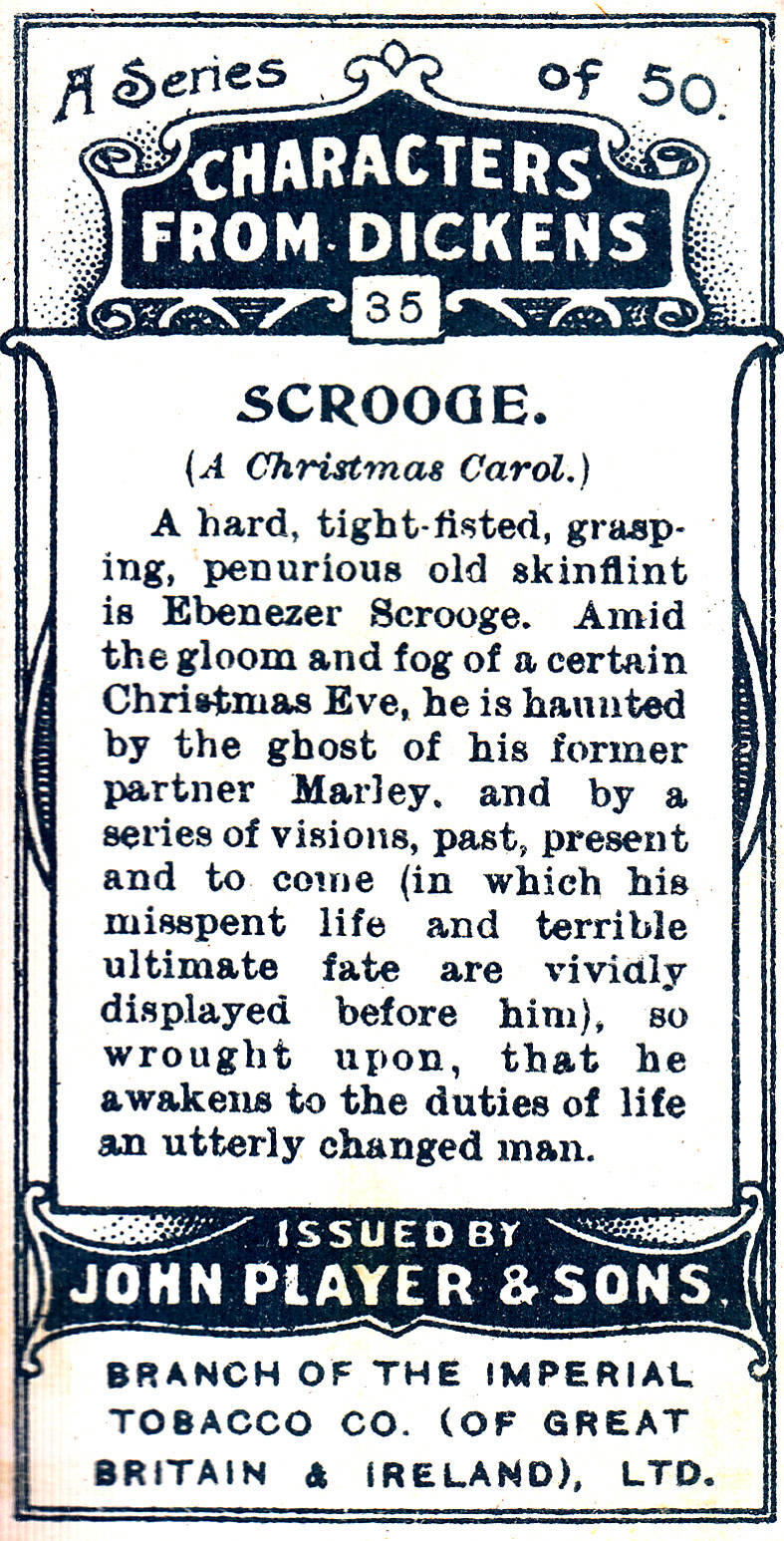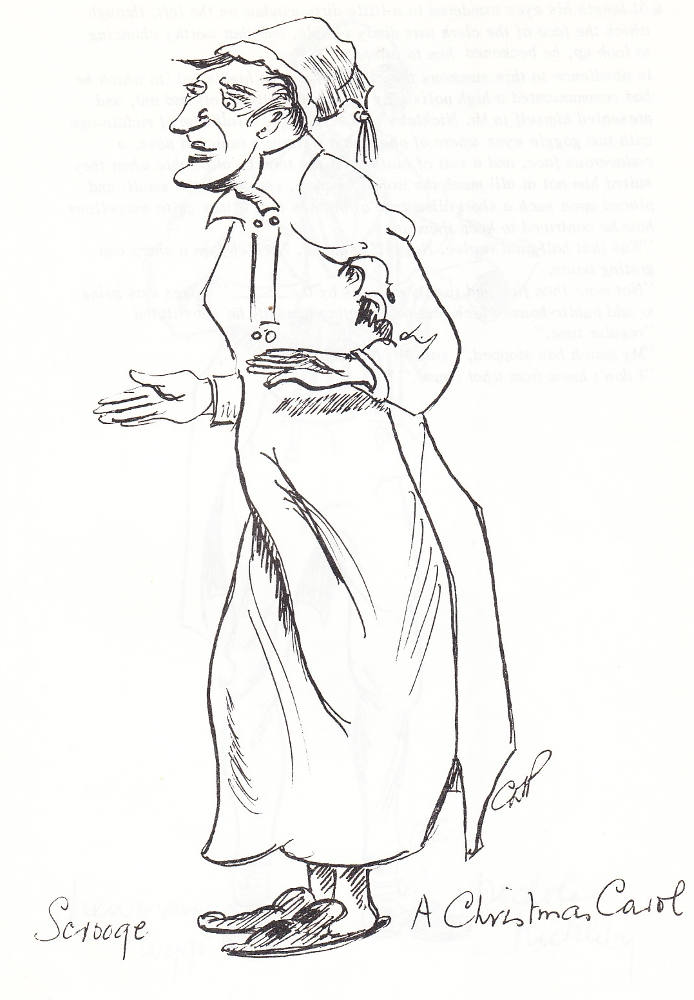

Scrooge by J. Clayton Clarke (“Kyd”) for the watercolour series (1910): reproduced on John Player cigarette card no. 35: Ninety-two Characters from Dickens: The Old Curiosity Shop. 2 ½ inches high by 1 ¼ inches wide (6.3 cm high by 3.3 cm wide). [Click on the images to enlarge them.]
SCROOGE (A Christmas Carol.)
A hard, tight-fisted, grasping, penurious old skinflint is Ebeneezer Scrooge. Amid the gloom and fog of a certain Christmas Eve, he is haunted by the ghost of his former partner Marley, and by a series of visions, past, present and to come (in which his misspent life and terrible ultimate fate are vividly displayed before him), so wrought upon, that he awakens to the duties of life an utterly changed man. [Verso of Card No. 35]
Passages Realised, from Brigden (1978)

Scrooge never painted out Old Marley's name. There it stood, years afterwards, above the warehouse door: Scrooge and Marley. The firm was known as Scrooge and Marley. Sometimes people new to the business called Scrooge Scrooge, and sometimes Marley, but he answered to both names. It was all the same to him.
Oh! but he was a tight-fisted hand at the grindstone, Scrooge! a squeezing, wrenching, grasping, scraping, clutching, covetous, old sinner! Hard and sharp as flint, from which no steel had ever struck out generous fire; secret, and self-contained, and solitary as an oyster. The cold within him froze his old features, nipped his pointed nose, shrivelled his cheek, stiffened his gait; made his eyes red, his thin lips blue; and spoke out shrewdly in his grating voice. A frosty rime was on his head, and on his eyebrows, and his wiry chin. He carried his own low temperature always about with him; he iced his office in the dog-days; and didn't thaw it one degree at Christmas. [Stave One, "Marley's Ghost," Household Edition of The Christmas Books, 2]
From "Stave Two: The First of the Three Spirits."
"Are you the Spirit, sir, whose coming was foretold to me?" asked Scrooge.
"I am!"
The voice was soft and gentle. Singularly low, as if, instead of being so close beside him, it were at a distance.
"Who and what are you?" Scrooge demanded.
"I am the Ghost of Christmas Past."
"Long Past?" inquired Scrooge; observant of its dwarfish stature.
"No. Your past." [Stave Two, Household Edition, 11]
Comment: Scrooge as the Only Character from The Christmas Books

Left: The original title-page for Chapman and Hall's seasonal novella, illustrated solely by John Leach in December 1843.
Of the set of 50 cigarette cards, initially produced in 1910 and reissued in 1923, only one is a "singleton" — a sole character from the Dickens work included among the ten books illustrated: Card No. 35, designated neither "Mr. Scrooge" or "Ebenezer Scrooge," but simply "Scrooge," perhaps the most famous of Dickens's fictional children. In Leech's original 1843 series of eight hand-tinted steel engravings, Scrooge appears six times — and in each he wears a nightcap and night-gown, as in Kyd's illustration. The Kyd series includes no other characters from The Christmas Books (1843-48), despite the enduring popularity of all five novellas long after the Hungry Forties, a longevity likely occasioned by continuing seasonal dramatic adaptions of the novella throughout the nineteenth century in Britain and America. Thus, the Player's Cigarette Card of Ebenezer Scrooge is distinctive in a number of ways, since all the other characters whom Kyd depicts come from novels, and each appears alongside several other characters from the same story. Scrooge is definitely a "one-off" in Kyd's "Characters from Dickens."
At the turn of the century, Kyd would have had several models from which to choose — although he may not have seen the work of American illustrators Sol Eytinge, Junior and E. A. Abbey, owing to copyright restrictions. J. Clayton Clarke would have been able to study multiple images of Ebenezer Scrooge produced Dickens's initial illustrator in 1843, John Leech, and the lead illustrator Fred Barnard for the 1878 Christmas Books volume in the Household Edition.

The book illustrations that most closely coincide with Kyd's interpretation of Scrooge in his nightcap and nightgown, carrying a lighted candle — Scrooge the dreamer, liberated from his daily "business" self, the "night side" of Scrooge, so to speak — are Barnard's Marley's Ghost (1878) and Leech's The Second of The Three Spirits, or Scrooge's third Visitor and Ignorance and Want (1843). Similar interpretations to which Kyd may not have access are those by E. A. Abbey, "What do you want with me?" (1876), and Sol Eytinge, Jr., Marley's Ghost (1868). Since Kyd gives neither background details nor other characters in order to establish a context, Scrooge in nightgown and nightcap may be responding to the strange noises that portend the arrival of his first Christmas "visitor," the Ghost of Jacob Marley, or he may simply be preparing to go to bed after his solitary dinner and cold walk home. Later illustrators apparently could not decide whether Scrooge should visit his future gravesite dressed only in his nightgown, or whether he should at least have the consolation of an embroidered dressing-gown.
Related Scrooge Illustrations from Various Editions, 1868-1910



Left: Eytinge's "In the Churchyard" (1868); centre: Furniss's's "The Last of the Spirits" (1910); right: Charles E. Brock's illustration focuses on Scrooge's reaction in Scrooge crept towards it, trembling as he went (1905).

Above: Arthur Rackham's's preparing the reader for the famous scene in the graveyard, Heading to Stave Four (1915).
Illustrations for A Christmas Carol (1843-1915)
- John Leech's original 1843 series of eight engravings for Dickens's A Christmas Carol
- Sol Eytinge, Junior's 1867-68 illustrations for two Ticknor & Fields editions for Dickens's A Christmas Carol
- E. A. Abbey's 1876 illustrations for The American Household Edition of Dickens's Christmas Books
- Fred Barnard's 1878 illustrations for The Household Edition of Dickens's Christmas Books
- Charles E. Brock's 1905 illustrations for A Christmas Carol and The Chimes
- A. A. Dixon's 1906 Collins Pocket Edition for Dickens's Christmas Books
- Harry Furniss's 1910 Charles Dickens Library Edition of Dickens's Christmas Books
- A selection of Arthur Rackham's 1915 illustrations for Dickens's A Christmas Carol
Scanned images and text by Philip V. Allingham.[You may use the images without prior permission for any scholarly or educational purpose as long as you (1) credit the person who scanned them and (2) link your document to this URL in a web document or cite the Victorian Web in a print one.]
Bibliography
Brigden, C. A. T. "No. 20. Scrooge, A Christmas Carol. The Characters from Charles Dickens as depicted by Kyd. Rochester, Kent: John Hallewell, 1978.
The Characters of Charles Dickens Pourtrayed in a Series of Original Water Colour Sketches by “Kyd.” London, Paris, and New York: Raphael Tuck & Sons, 1898[?].
Davis, Paul. Charles Dickens A to Z: The Essential Reference to His Life and Work. New York: Checkmark and Facts On File, 1999.
Davis, Paul. The Lives and Times of Ebenezer Scrooge. New Haven: Yale UP, 1990.
Dickens, Charles. Christmas Books. Illustrated by Sol Eytinge, Junior. Diamond Edition. 14 vols. Boston: Ticknor and Fields, 1867.
_____. Christmas Books. Illustrated by Fred Barnard. Household Edition. 22 vols. London: Chapman and Hall, 1878. Vol. XVII.
_____. Christmas Books. Illustrated by A. A. Dixon. London & Glasgow: Collins' Clear-Type Press, 1906.
_____. Christmas Books. Illustrated by Harry Furniss. The Charles Dickens Library Edition. 18 vols. London: Educational Book, 1910. Vol. VIII.
_____. A Christmas Carol in Prose, Being a Ghost Story of Christmas. Illustrated by John Leech. London: Chapman and Hall, 1843.
_____. A Christmas Carol in Prose: Being a Ghost Story of Christmas. Illustrated by Sol Eytinge, Jr. Boston: Ticknor & Fields, 1868.
_____. A Christmas Carol in Prose, Being A Ghost Story of Christmas. Illustrated by John Leech. (1843). Rpt. in Charles Dickens's Christmas Books, ed. Michael Slater. Hardmondsworth: Penguin, 1971, rpt. 1978.
____. A Christmas Carol and The Cricket on the Hearth. Illustrated by Charles Edmund Brock. London: J. M. Dent, and New York: Dutton, 1905, rpt. 1963.
_____. A Christmas Carol. Illustrated by Charles Green, R. I. London: A & F Pears, 1912.
_____. A Christmas Carol. Illustrated by Arthur Rackham. London: William Heinemann, 1915.
_____. Christmas Stories. Illustrated by E. A. Abbey. The Household Edition. 16 vols. New York: Harper and Brothers, 1876.
Kyd. Characters from Dickens. Nottingham: John Player & Sons, 1910.
Created 12 January 2015
Last modified 20 July 2025